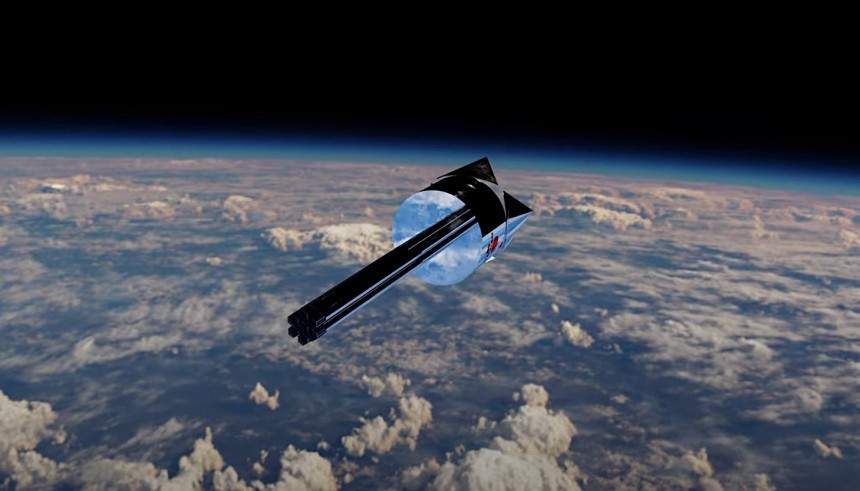When you think of today's space rockets you think of a system comprising a small number of boosters (up to three, most commonly) on top of which the payload in need of delivery to orbit or elsewhere is strapped. The boosters, which hold fuel and engines, are generally large, and they do get the job done.
It's a way of doing things that has worked for a long time now, despite being, at least until the advent of reusable boosters, prohibitively expensive. But it's also a way of doing things that didn't seem right to German national Lutz Kayser.
The aerospace engineer is the man who back in the 1970s set up a company called Orbital Transport und Raketen (OTRAG). It's a company that no one really remembers today, not because it isn't worth remembering, but because its wacky take on what a rocket should be never made it into the real world.
You see, instead of using up to three standard boosters to get stuff into space, the OTRAG rockets were essentially designed as nothing more than pipes linked and stacked together, strapped under the payload.
The goal was not to devise some new and revolutionary means of orbital transport but to cut the cost of launches by using a modular approach that meant the rocket could be adapted to the customers' needs.
Key to this modularity were the pipes I mentioned earlier. They were to act just like today's boosters, being filled with fuel which was then ignited and shot out the Earth-pointing end of each pipe. This pushed the seemingly makeshift rocket up and into orbit.
Depending on needs, the pipes could be linked together either in a single bunch, to create a single stage, or more bunches, stacked on top of one another to create multiple stages.
Each pipe used for this purpose was a mere 27 cm (10 inches) in diameter and 6 meters (20 feet) long. By comparison, the Falcon 9 booster is huge, coming in at 3.7 meters (12 feet) in diameter. To get a more solid booster, up to six of these pipes could be placed one on top of the other to form individual fuel tanks capable of pushing cargo upwards.
Each pipe was to be filled with kerosene, while an equal mixture of nitric acid and dinitrogen tetroxide was to act as oxidizer. Furfuryl alcohol injected before the fuel was to be the source of ignition.
The design of the pipes and the goal of such a crazy rocket did not allow for pumps to be used to push fuel to the engines, so the pressure provided by compressed air did the job instead – each pipe would not hold fuel more than 66 percent capacity, the rest of the space was occupied by compressed air.
As for capabilities, the German rocket was designed to launch any two-ton satellite developed by the companies of the 1970s. But because it was modular it could be assembled in such a way as to lift five times more weight to geostationary orbit.
Technically speaking, even if the entire concept looks a bit primitive, it would have allowed a clear reduction in launch cost due to modularity, mass-scale production of components, and simplicity. As per estimates at the time, launching a satellite using the OTRAG would have been 90 percent cheaper than when using conventional means.
We're all too young to remember anything about it, but OTRAG, which was an active company for about 13 years, didn't limit itself to sketching these ideas on a piece of paper. It got a stage where it even conducted some test flights of individual modules.
History books note that the company managed to perform some 6,000 static tests on the rocket's engines, and more than a dozen single-stage qualification tests. No full-size prototype was ever made and flown.
Why, if the concept was so promising, did the OTRAG rocket never come to be? The simple answer is a mixture of political interference and the arrival of the Ariane family of rockets (conventional ones, but backed by government actors).
Because no actual prototype was ever flown it's very hard for us average Joes to imagine how the OTRAG would have looked like on the launch pad and later on climbing to its designated place in orbit.
Luckily, it's 2023 we live in, and the technology is advanced enough to allow us to digitally imagine such amazing things.
The video below, the work of space tech animation specialist Hazegrayart, shows exactly how the OTRAG rocket would have worked had it ever been made. We get to see a multi-stage version of it, from right when pad workers bring together the many booster pipes that are needed for launch, to the moment it reaches orbit and deploys its cargo.
As for whether we'll ever get to see such an insane concept in action, only time will tell. That's because most present-day space companies are taking a different approach and focus on reusability.
The aerospace engineer is the man who back in the 1970s set up a company called Orbital Transport und Raketen (OTRAG). It's a company that no one really remembers today, not because it isn't worth remembering, but because its wacky take on what a rocket should be never made it into the real world.
You see, instead of using up to three standard boosters to get stuff into space, the OTRAG rockets were essentially designed as nothing more than pipes linked and stacked together, strapped under the payload.
The goal was not to devise some new and revolutionary means of orbital transport but to cut the cost of launches by using a modular approach that meant the rocket could be adapted to the customers' needs.
Key to this modularity were the pipes I mentioned earlier. They were to act just like today's boosters, being filled with fuel which was then ignited and shot out the Earth-pointing end of each pipe. This pushed the seemingly makeshift rocket up and into orbit.
Depending on needs, the pipes could be linked together either in a single bunch, to create a single stage, or more bunches, stacked on top of one another to create multiple stages.
Each pipe was to be filled with kerosene, while an equal mixture of nitric acid and dinitrogen tetroxide was to act as oxidizer. Furfuryl alcohol injected before the fuel was to be the source of ignition.
The design of the pipes and the goal of such a crazy rocket did not allow for pumps to be used to push fuel to the engines, so the pressure provided by compressed air did the job instead – each pipe would not hold fuel more than 66 percent capacity, the rest of the space was occupied by compressed air.
As for capabilities, the German rocket was designed to launch any two-ton satellite developed by the companies of the 1970s. But because it was modular it could be assembled in such a way as to lift five times more weight to geostationary orbit.
Technically speaking, even if the entire concept looks a bit primitive, it would have allowed a clear reduction in launch cost due to modularity, mass-scale production of components, and simplicity. As per estimates at the time, launching a satellite using the OTRAG would have been 90 percent cheaper than when using conventional means.
We're all too young to remember anything about it, but OTRAG, which was an active company for about 13 years, didn't limit itself to sketching these ideas on a piece of paper. It got a stage where it even conducted some test flights of individual modules.
Why, if the concept was so promising, did the OTRAG rocket never come to be? The simple answer is a mixture of political interference and the arrival of the Ariane family of rockets (conventional ones, but backed by government actors).
Because no actual prototype was ever flown it's very hard for us average Joes to imagine how the OTRAG would have looked like on the launch pad and later on climbing to its designated place in orbit.
Luckily, it's 2023 we live in, and the technology is advanced enough to allow us to digitally imagine such amazing things.
The video below, the work of space tech animation specialist Hazegrayart, shows exactly how the OTRAG rocket would have worked had it ever been made. We get to see a multi-stage version of it, from right when pad workers bring together the many booster pipes that are needed for launch, to the moment it reaches orbit and deploys its cargo.
As for whether we'll ever get to see such an insane concept in action, only time will tell. That's because most present-day space companies are taking a different approach and focus on reusability.











